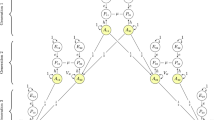Abstract
Johnsonet al. (Behav. Genet. 17:1–7, 1987) have interpreted an apparent decline in assortative mating for educational attainment in Hawaii as being a consequence of increased social mobility and increased access to higher education. Data on the educational attainments of adult twin pairs and their spouses from the Virginia twin registry are reported which give no indication of a major decline in the intensity of assortative mating. A previous study of a Norwegian population (Heathet al., Behav. Genet. 15:349–369, 1985), in which an increase in equality of educational opportunity had been documented (Heathet al., Nature 314:734–736, 1985), observed remarkable constancy of the marital correlation for educational attainment. There is thus little evidence that decreases in social inequality in a society lead to a decline in assortative mating.
Similar content being viewed by others
References
Ahern, F. M., Johnson, R. C., and Cole, R. E. (1983). Generational differences in spouse similarity in educational attainment.Behav. Genet 13:95–98.
Blau, P. M., and Duncan, O. D. (1967).The American Occupational Structure, New York, Wiley.
Bulmer, M. D. (1970).The Biology of Twinning in Man, Clarendon Press, Oxford.
Duncan, O. D. (1968). Ability and achievement.Eugen. Q. 15:1–11.
Fisher, R. A. (1918). The correlation between relatives on the supposition of Mendelian inheritance.Trans. Roy. Soc. Edinburgh 52:399–433.
Heath, A. C., and Berg, K. (1985). Effects of social policy on the heritability of educational achievement. In Berg, K. (ed.).Medical Genetics: Past, Present, Future, Alan R. Liss, New York.
Heath, A. C., and Eaves, L. J. (1985). Resolving the effects of phenotype and social background on mate selection.Behav. Genet. 15:15–30.
Heath, A. C., Berg, K., Eaves, L. J., Solaas, M. H., Sundet, J., Nance, W. E., Corey, L. A., and Magnus, P. (1985a). No decline in assortative mating for educational level.Behav. Genet. 15:349–369.
Heath, A. C., Berg, K., Eaves, L. J., Solaas, M. H., Corey, L. A., Sundet, J., Magnus, P., and Nance, W. E. (1985b). Education policy and the heritability of educational attainment.Nature 314:734–736.
Heath, A. C., Eaves, L. J., and Berg, K. (1986). Resolving the determinants of mate selection: Application of a new paradigm (submitted for publication).
Heath, A. F. (1981).Social Mobility, Fontana, Glasgow.
Johnson, R. C., Ahern, F. M., and Cole, R. E. (1980). Secular change in degree of assortative mating for ability?Behav. Genet. 10:1–8.
Johnson, R. C., Nagoshi, C. T., Ahern, F. M., Wilson, J. R., DeFries, J. C., McClearn, G. E., and Vandenberg, S. G. (1983). Family background, cognitive ability, and personality as predictors of educational and occupational attainment.Soc. Biol. 30:86–100.
Johnson, R. C., Nagoshi, C. T., and Ahern, F. M. (1987). A reply to Heathet al. on assortative mating for educational level.Behav. Genet. 17:1–7.
Jones, F. L. (1971). Occupational achievement in Australia and the United States: A comparative path analysis.Am. J. Sociol 77:527–539.
Magnus, P., Berg, K., and Nance, W. E. (1983). Predicting zygosity in Norwegian twin pairs born 1915–1960.Clin. Genet. 24:103–112.
Olsson, U. (1979). Maximum-likelihood estimation of the polychoric correlation coefficient.Psychometrika 44:443–460.
Rice, J., Cloninger, C. R., and Reich, T. (1978). Multifactorial inheritance with cultural transmission and assortative mating. I. Description and basic properties of the unitary models.Am. J. Hum. Genet. 30:618–643.
Scarr-Salapatek, S. (1971). Unknowns in the IQ equation.Science 174:1223–1228.
Author information
Authors and Affiliations
Additional information
This work was supported in part by NIH Grants GM30250, AG04954 and GM32732 and by ADAMHA Grants AA06781 and MH40828.
Rights and permissions
About this article
Cite this article
Heath, A.C., Eaves, L.J., Nance, W.E. et al. Social inequality and assortative mating: Cause or consequence?. Behav Genet 17, 9–17 (1987). https://doi.org/10.1007/BF01066007
Received:
Accepted:
Issue Date:
DOI: https://doi.org/10.1007/BF01066007




